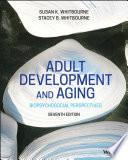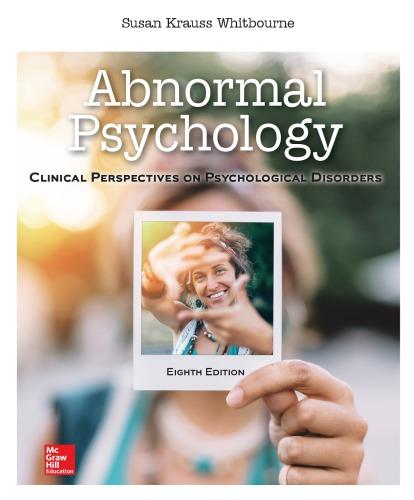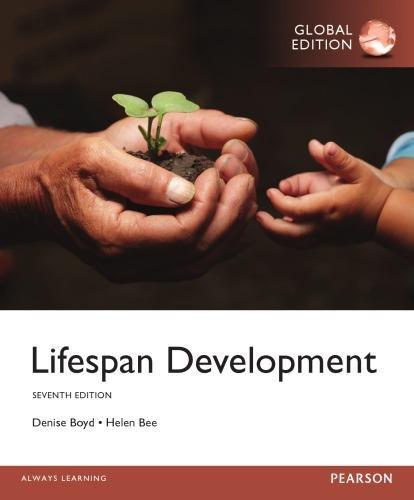ADULT DEVELOPMENT & AGING: Biopsychosocial Perspectives 7th Edition Susan Krauss Whitbourne Visit to download the full and correct content document: https://ebookmass.com/product/adult-development-aging-biopsychosocial-perspectiv es-7th-edition-susan-krauss-whitbourne/
More products digital (pdf, epub, mobi) instant download maybe you interests ...
Abnormal psychology: clinical perspectives on psychological disorders (8th Ed.) 8th. Edition Susan Krauss Whitbourne
https://ebookmass.com/product/abnormal-psychology-clinicalperspectives-on-psychological-disorders-8th-ed-8th-edition-susankrauss-whitbourne/
Adult Development and Aging 8th Edition, (Ebook PDF)
https://ebookmass.com/product/adult-development-and-aging-8thedition-ebook-pdf/
eTextbook 978-1285444918 Adult Development and Aging
https://ebookmass.com/product/etextbook-978-1285444918-adultdevelopment-and-aging/
ISE Abnormal Psychology: Clinical Perspectives on Psychological Disorders 10th Edition Whitbourne Professor
https://ebookmass.com/product/ise-abnormal-psychology-clinicalperspectives-on-psychological-disorders-10th-edition-whitbourneprofessor/
Gendered Lives: Intersectional Perspectives 7th Edition
Gwyn Kirk
https://ebookmass.com/product/gendered-lives-intersectionalperspectives-7th-edition-gwyn-kirk/
Today’s Moral Issues: Classic and Contemporary Perspectives, 7th edition 7th Edition, (Ebook PDF)
https://ebookmass.com/product/todays-moral-issues-classic-andcontemporary-perspectives-7th-edition-7th-edition-ebook-pdf/
Lifespan Development 7th Edition – Ebook PDF Version
https://ebookmass.com/product/lifespan-development-7th-editionebook-pdf-version/
Lifespan development 7th, global Edition Denise Boyd
https://ebookmass.com/product/lifespan-development-7th-globaledition-denise-boyd/
Child Development Robert S. Feldman
https://ebookmass.com/product/child-development-robert-s-feldman/
ADULTDEVELOPMENT& AGING BIOPSYCHOSOCIALPERSPECTIVES ADULTDEVELOPMENT& AGING BIOPSYCHOSOCIALPERSPECTIVES
SeventhEdition
SusanKraussWhitbourne,Ph.D.
UniversityofMassachusettsBoston
StaceyB.Whitbourne,Ph.D.
VABostonHealthcareSystem
VPANDEDITORIALDIRECTORVeronicaVisentin
EXECUTIVEEDITORGlennWilson
EDITORIALASSISTANTJannilPerez
EDITORIALMANAGERJudyHowarth
CONTENTMANAGEMENTDIRECTORLisaWojcik
CONTENTMANAGERNicholeUrban
SENIORCONTENTSPECIALISTNicoleRepasky
PRODUCTIONEDITORVinoliaBenedictFernando
COVERPHOTOCREDITCourtesyofSusanK.Whitbourne&StaceyB.Whitbourne
Thisbookwassetin9.5/11.5BerkeleyStd-BookbySPiGlobalandprintedandboundbyQuadGraphics.
Foundedin1807,JohnWiley&Sons,Inc.hasbeenavaluedsourceofknowledgeandunderstandingformorethan200years, helpingpeoplearoundtheworldmeettheirneedsandfulfilltheiraspirations.Ourcompanyisbuiltonafoundationofprinciples thatincluderesponsibilitytothecommunitiesweserveandwhereweliveandwork.In2008,welaunchedaCorporate CitizenshipInitiative,aglobalefforttoaddresstheenvironmental,social,economic,andethicalchallengeswefaceinour business.Amongtheissuesweareaddressingarecarbonimpact,paperspecificationsandprocurement,ethicalconductwithin ourbusinessandamongourvendors,andcommunityandcharitablesupport.Formoreinformation,pleasevisitourwebsite: www.wiley.com/go/citizenship.
Copyright c 2020,2017,2014,2011,2008,2005JohnWiley&Sons,Inc.Allrightsreserved.Nopartofthispublicationmay bereproduced,storedinaretrievalsystem,ortransmittedinanyformorbyanymeans,electronic,mechanical,photocopying, recording,scanningorotherwise,exceptaspermittedunderSections107or108ofthe1976UnitedStatesCopyrightAct, withouteitherthepriorwrittenpermissionofthePublisher,orauthorizationthroughpaymentoftheappropriateper-copyfeeto theCopyrightClearanceCenter,Inc.,222RosewoodDrive,Danvers,MA01923(Website:www.copyright.com).Requeststothe PublisherforpermissionshouldbeaddressedtothePermissionsDepartment,JohnWiley&Sons,Inc.,111RiverStreet, Hoboken,NJ07030-5774,(201)748-6011,fax(201)748-6008,oronlineat:www.wiley.com/go/permissions.
Evaluationcopiesareprovidedtoqualifiedacademicsandprofessionalsforreviewpurposesonly,foruseintheircoursesduring thenextacademicyear.Thesecopiesarelicensedandmaynotbesoldortransferredtoathirdparty.Uponcompletionofthe reviewperiod,pleasereturntheevaluationcopytoWiley.Returninstructionsandafreeofchargereturnshippinglabelare availableat:www.wiley.com/go/returnlabel.Ifyouhavechosentoadoptthistextbookforuseinyourcourse,pleaseacceptthis bookasyourcomplimentarydeskcopy.OutsideoftheUnitedStates,pleasecontactyourlocalsalesrepresentative.
ISBN:978-1-119-60787-8(PBK)
ISBN:978-1-119-60939-1(EVALC)
LibraryofCongressCataloging-in-PublicationData
Names:Whitbourne,SusanKrauss,author. | Whitbourne,StaceyB.,author. Title:Adultdevelopmentandaging:biopsychosocialperspectives/Susan KraussWhitbourne,e,Ph.D.,UniversityofMassachusettsBoston,Stacey B.Whitbourne,Ph.D.,VABostonHealthcareSystem.
Othertitles:Adultdevelopment&aging
Description:SeventhEdition. | Hoboken:Wiley,2020. | Revisededitionof theauthors’Adultdevelopment&aging,[2017] | Includes bibliographicalreferencesandindex.
Identifiers:LCCN2020004059(print) | LCCN2020004060(ebook) | ISBN 9781119607878(paperback) | ISBN9781119609438(adobepdf) | ISBN 9781119609377(epub)
Subjects:LCSH:Gerontology. | Olderpeople—Psychology. | Older people—Healthandhygiene. | Olderpeople—Socialconditions. Classification:LCCHQ1061.W482020(print) | LCCHQ1061(ebook) | DDC 305.26—dc23
LCrecordavailableathttps://lccn.loc.gov/2020004059
LCebookrecordavailableathttps://lccn.loc.gov/2020004060
Theinsidebackcoverwillcontainprintingidentificationandcountryoforiginifomittedfromthispage.Inaddition,iftheISBN onthebackcoverdiffersfromtheISBNonthispage,theoneonthebackcoveriscorrect.
Everyoneages.Thisveryfactshouldbe enoughtodrawyouintothesubjectmatter ofthiscourse,whetheryouarethestudent ortheinstructor.Yet,formanypeople,it isdifficulttoimaginethefuturein50,40, oreven10yearsfromnow.Thegoalofour bookistohelpyouimagineyourfutureandthefuture ofyourfamily,yourfriends,andyoursociety.Wehave broughttogetherthelatestscientificfindingsaboutaging withamorepersonalapproachtoencourageyoutotake thisimaginativejourneyintoyourfuture.
Theseventheditionof AdultDevelopmentandAging: BiopsychosocialPerspectives incorporatesmaterialthatwe believeisvitaltoyourunderstandingofthisrapidlydevelopingandfascinatingfieldofstudy.Muchofwhatyou willreadcomesdirectlyfromSusan’sclassroomteachingofthepsychologyofagingcourseattheUniversity ofMassachusettsBoston.Shecontinuestoincorporateher day-to-dayteachingofthecourseintothetext,whichkeeps thematerialcurrent,fresh,andengaging.Atthesametime, heractiveinvolvementinresearchonthepsychologyof adultdevelopmentandaginggiveshertheabilitytosift throughtheavailablefindingsandpulloutthosethatare centraltoanunderstandingofindividualsastheychange fromtheyearsofearlyadulthoodthroughlatelife.
Staceywasinspiredtopursuethefieldofagingaftertakinghermother’scourseattheUniversityofMassachusetts Amherst.Shecontinuedhergraduateworkinsocialand developmentalpsychology,focusingoncognitivefunctioninginlateradulthood.Staceyistheprogramdirectorfor amajornationalinitiativethatisbuildingahealthand genomicdatabaseforfuturestudiesofmilitaryveterans. HavingalsotaughtadultdevelopmentandagingatBrandeis UniversityandtheUniversityofMassachusettsBoston,she isalsoattunedtostudentneedsandinterests.
WeareproudtosaythatStaceyisthethirdgeneration ofherfamilytobeinvolvedinthefieldofgerontology. TheodoreC.Krauss,M.D.,Susan’sfather,wasaninnovatoringeriatricmedicine.Susanbecameinterestedin
thescholarlyfieldofagingasanundergraduatewhenshe decidedtowriteapaperonpersonalityandadaptation inadevelopmentalpsychologycourse.Atthesametime, herfather’sprofessionalactivitieshadaprofoundinfluence andmadethechoiceofgerontology(thescientificstudyof aging)anaturalone.
Itisourhopeandbeliefthatyouwillfindyourself asengrossedinthepsychologyofadultdevelopmentand agingasweare.Notonlyiseveryonearoundyouaging butalsotheissuesthatresearchersinfieldexaminerange allthewayfromthephilosophicaltothepractical.Whydo livingthingsage?Isthereawaytoslowdowntheaging process?HowwillsocietydealwiththeagingoftheBaby Boomers?Howwilljobmarketsbeaffectedbyanaging society?Willtheyoungadultsoftodayagedifferently thandidtheirparentsandgrandparents?Bringingittoa personallevel,asyoutakethecourse,you’llstarttoask questionsaboutyourownlife.Whatchallengesawaityou asyoubeginyourcareer?Whatwillitbeliketostarta family?Howwillyoumanagethetransitionintoyourearly adulthoodasyouleavecollegebehindtopursueyourown life?Allofthese,andmore,arequestionsthatyouwillfind yourselfaskingasyouexplorethemanycomplexitiesofthe processthatcausespeopletochangeandgrowthroughout life.Youwilllearnnotonlyhowpeoplegrowolderbut alsohowtogrowolderinawaythatishealthyand satisfying.
THEMESOFTHEBOOK Thebiopsychosocialmodelemphasizedinourtextis intendedtoencourageyoutothinkaboutthemultiple interactionsamongthedomainsofbiology,psychology, andsociology.Accordingtothismodel,changesinone areaoflifehaveeffectsonchangesinotherareas.The centerpieceofthismodelisidentity,yourself-definition. Youinterprettheexperiencesyouhavethroughtheframeworkprovidedbyyouridentity.Inturn,yourexperiences stimulateyoutochangeyourself-definition.
Thisisanexcitingtimetobestudyingadultdevelopmentandaging.Thetopicisgainingincreasingmedia attentionandtremendousmomentumasanacademic disciplinewithinlifespandevelopment.Thebiopsychosocialmodelfitswithintheframeworkofcontemporary approachestakingholdinthesciencesingeneralthat emphasizetheimpactofsocialcontextonindividuals throughoutallperiodsoflife.Entirelynewconcepts,sets ofdata,andpracticalapplicationsofthesemodelsare resultinginarealizationofthedreamsofmanyofthe classicdevelopmentalpsychologistswhoseworkshaped thefieldintheearly20thcentury.
Adultdevelopmentandagingareareasthathaveno nationalboundaries.Agingisnowbeingrecognizedas apriorityforresearchersandpolicymakersaroundthe world,notonlyintheUnitedStatesandCanada.Wecan allbenefitfromthisinternationalperspectivebothforour owncountriesandforthoseofcitizensaroundtheworld.
ORGANIZATION Ifyoureadthechaptersofthisbookinorderfromstartto finish,youwillprogressfromthebasicsinthefirstthree chapterstomorecomplexissues,startinginChapter4,that placerelativelymoreemphasisonthe‘‘bio,’’the‘‘psycho,’’ andthe‘‘social.’’However,notallinstructorschooseto proceedinthisfashion,andwehavedesignedthebook withthisflexibilityasanoption.Weemphasizethebiopsychosocialmodelthroughout,inthatmanyofthetopics, regardlessofwheretheyappearinthebook,spanareasas diverse,forexample,asdrivinganddiabetes.
Wedorecommend,though,thatthelastchapteryou readisnottheoneondeathanddying,asisoftenthecasein otherbooksinthefield.Ourlastchaptercoverssuccessful aging.Manystudentsandinstructorshavesharedwithus theirappreciationofourendingona‘‘highnote.’’Even thoughdeathisobviouslythefinalperiodoflife,weeach havethepotentialtoliveonafterourownendingthrough theworkswecreate,thelegaciesweleavebehind,andthe peoplewhoseliveswehavetouched.Thesearethethemes thatwewouldlikeyoutotakewithyoufromthisbookin theyearsanddecadesahead.
FEATURES Up-to-DateResearch Thetopicsandfeaturesinthistext areintendedtoinvolveyouinthefieldofagingfroma scholarlyandpersonalperspective.Youwillfindthatthe mostcurrentresearchispresentedthroughoutthetext, withcarefulanddetailedexplanationsofthestudiesthat highlightthemostimportantscholarlyadvances.Wehave
givenparticularattentiontonewtopicsandapproaches, includingneuroscienceandgenetics,aswellascontinuing tobringtostudentsthelatestadvancesincognition,personality,relationships,andvocationaldevelopmentaswell ashighlightingsocioculturalinfluencesondevelopment, includingrace,ethnicity,andsocialclass.
AgeFeed Thechaptersbeginwithourveryown‘‘AgeFeed’’openerstogiveyouanintroductiontothetopic. Theseareintheformoffactversusmythchallenges, self-tests,orlistsrelevanttoeachchapterthattakeone ofseveralformats.ForAgeFeedopenersthatinvolvea challengeorself-test,theanswersareprovidedforyouso thatyoucanscoreyourself.Yourinstructormaydecideto assignthesetotests,sobesuretoreadthemovercarefully. Wehopeyoulikethem!
EngagingFiguresandTables Allofthefiguresandphotographsinthisseventheditionwereredesignedfrom thepreviouseditionswithupdatedinformationandformats.Thesewillhelpyoulearnandrememberthekey informationpresentedinthetext.Ourselectionofthese materialsconnectstothePowerPointslidesthatinstructors candownloadfromtheWileywebsite.
ContemporaryApproach Withcoauthorsliterallyone generationapart,it’sbeenourgoaltofindthebalance betweenthe‘‘professor’’andthe‘‘student’’perspectives. Asaresult,youwillfindmanycurrentexamplesrelevant topeopleinyouragegroup,whetheryou’reareturning studentorastudentoftraditionalcollegeage.Instructors, too,willfindmaterialthattheycanrelatetotheirown experiences,whethertheyarerelativenewcomersormore seasonedacademics.
STUDENTLEARNINGAIDS GlossaryTerms Wehavemadeaconcertedeffortin thiseditiontoprovidealargenumberofglossaryterms, indicatedinboldineachchapter,andlistedattheend ofthebook.Althoughitmayseemlikeyouwillhavea greatmanytermstomemorize,thefactofthematteris thatyouwillneedtolearnthemanyway,andbyhaving themprovidedinyourglossary,you’llfinditeasierto spotthemwhenitcomestimetoreviewforyourexams. Susanfindsthatherstudentsliketostudyfromflashcards thattheymakeup,andifyoufindthisausefulstudy tool,theglossarytermswillmakethatprocessmuch morestraightforward.Themajorityofthesetermsrelate specificallytoadultdevelopmentandaging,butwherewe feltitwashelpfulforyoutoreviewatermthatyoumay
nothaveencounteredforawhile,wealsoincludedseveral termsofamoregeneralnature.
NumberedSummaries Youwillfindanumberedsummaryforeachchapterthatwillsupplementyourstudying andhelpyounarrowdownyourreviewingtothechapter’s mainpoints.Togetherwiththeglossaryterms,thesewill giveyouacomprehensiveoverview,thoughtheywillhelp youthemostifyouactuallyreadthechaptersthemselves.
CHANGESINTHESEVENTHEDITION Thefirsteditionof AdultDevelopmentandAging:BiopsychosocialPerspectives wasintendedtoprovideafreshand engagingapproachtothefieldofthepsychologyofadult developmentandagingbyfocusingonthreethemes:a multidisciplinaryapproach,positiveimagesofaging,and thenewestandmostrelevantresearch.Wecontinuethis traditionintheseventheditionbecausewewantyou,our readers,tofeelasconnectedtothematerialaspossible. Ourthinkingisthatstudentswillbemoremotivatedto completetheirreadingiftheylikethetextandfeelthat theycanrelatetoit.Atthesametime,instructorswill findtheirjobthatmucheasierbecausestudentssittingin theirclassroomswillcometoclassreadytodiscusswhat they’veread.
Instructorswhohavedevelopedtheircoursebasedon earliereditionswillnotneedtochangethebasicstructure oftheirlecturesandassignments.However,toreflectthis ever-changingfield,weshiftedmaterialwithinthechapters, insomecasesdeletingtopicsthatbynowarenolonger consideredrelevantinordertomakeroomtocoverthe newerapproachesthathavecomeintoprominencewithin thepast3years.
Althoughmanyoftheclassicsremain,wehaveincluded over500referencesfromthepast3years,upthrough mid-2019.Invirtuallyallcaseswherewereferencepopulationdata,werelyonsourcesfrom2018and2019. Wealsogiveexpandedcoveragetoglobalpopulationand healthdatainkeepingwithourstatedgoalofprovidingan internationalperspective.
Inthesixthedition,werevampedmuchofthetopicalorganizationtobeconsistentwithnewdevelopments intheoryandresearch.Inthepresentedition,wehave trimmedsomeareasthathadbecomeoutdatedevenfurtherinordertobeabletocovertheemergingliterature. Additionally,tomakethenewmaterialconsistentwith theillustrations,wehaveprovidednarrativesthatwill allowreaderstounderstandthemainpointsofeachofthe revampedfigures.Thesechangescameabout,inpart,asa resultoffeedbackfromstudentsinSusan’sundergraduate courseingerontology.
Severaltrendsintheliteraturethatarereflectedin theseventheditionincludegreaterappreciationofthe roleofsocialcontextasaninfluenceondevelopment suchasincomeinequity,variationsaccordingtosuch areasofdiversityasrace,ethnicity,andsexualorientation. Wealsoexpandourtreatmentofinternationalvariations andincludeconsiderablematerialfromtheWorldHealth Organization’sfocuson‘‘ActiveandHealthyAgeing.’’All referencespriorto2015havebeencheckedtodetermine whethernewerinformationisavailable.Wheresectionsof thetextcoveredtopicsthathavediminishedinimportance inthefield,thesehavebeencondensedoreliminated.As aresult,althoughthetext’sstructureremainsconsistent, therearenewareasofemphasisreflectingthegrowthof thefield.
Ourgoalistoprovidethelatestfindingswhilepreservinginformationofrelevancetothe‘‘classic’’studiesinthe field.Studentswillthereforehavethebestofallworlds, withtheopportunitytolearnaboutcherishedtraditionsin adultdevelopmentandagingbutalsotolearnwherethis excitingfieldisheadedinthecomingdecades.
Supplements Wileyispleasedtoofferanonlineresource containingawealthofteachingandlearningmaterialsat http://www.wiley.com/college/whitbourne.
WebsiteLinks Referencesinthiseditionshowthewebsitesthatstudentsandinstructorscanconsulttogather updatedinformationonchangesinthefield.
INSTRUCTORRESOURCES Instructor’sManual ThecontentintheInstructor’sManualreflectsthe45yearsofexperiencethatSusanhasin teachingthiscourse.Youwillfindchapteroutlines,key terms,learningobjectives,andlecturesuggestions.We haveupdatedoursuggestionsforvideos,takingadvantage ofthenewresourcesavailablethroughYouTube,andalso provideinstructorswithresourcesforfilms,music,and literature.
PowerPointSlides Preparedforuseinlectures,weprovideyouwithacompletesetofPowerPointslidestested inSusan’sclassanddesignedspecificallyforthisbook. Instructorscaneasilyadaptthemfortheirownspecific needs.
TestBank Instructorshaveaccesstoacompletedownloadabletestbankthatincludes50questionsineach chapterthatfollowtheorderinwhichconceptsarepresentedinthetext.Eachmultiple-choicequestionislabeled
accordingtotheconceptittests,alongwithitsdifficulty level(basedonclasstesting).Weincludeshortanswerand essayquestionsthatcorrespondwitheachsectionofthe chapter.BecausetheyareinconvenientMicrosoftWord format,instructorscanadaptthemtotheirownparticular needs.
ACKNOWLEDGMENTS Ourfirstsetofacknowledgmentsgoestoourfamilies.HusbandsRichardO’BrienandErikGleasonhavegraciously providedimportantsupportthatallowedustospendthe manyhoursweneededovertheperiodofayeartorevise thebook.JenniferO’Brien,daughterandsister,isawonderfulsoundingboardforourideas;asshecontinuesher careerinclinicalpsychology,welookforwardtocontinued ‘‘collaboration’’withher.Wewouldalsoliketothankthe newestmembersofourfamily—namelyTheodoreJames Gleason,age8atthetimeofthiswriting,andScarlettBeth Gleason,whohasjustturned6.Susanisthrilledtobea grandmother,experiencingthejoysofthisspecialstatus onafirst-handbasis.
Throughoutthewritingofthisbook,studentsinthe MentalHealthandAgingclassattheUniversityofMassachusettsBostonhaveprovidedvaluableinsightsand observations.Aswewererevisingthebookandpreparing thelectures,studentscontinuedtoprovideuswithfresh perspectives.Theirgoodhumor,patience,andwillingness toexperimentwithsomenewideashavemadeitpossible toaddtheall-importantstudentviewpointtothefinished product.WealsoappreciatethecontributionsofSusan’s graduateteachingassistants,whoserveassoundingboards inherpreparationandreviewoflecturecontent.
Ourfinalthanksgotothereviewersovertheyears whoprovidedhelpfulcomments.Theirinsightfulobservationsandthoughtfulproposalsforchangeshelpedus tightenandfocusthemanuscriptandenhancethediscussionofseveralkeyareasofinterestinthefield. ThankyoutoAlexBishop(OklahomaStateUniversity), SueBurdett-Robinson(Hardin-SimmonsUniversity),Alvin House(IllinoisStateUniversity),GaryMontgomery(The UniversityofTexas-PanAmerican),andNancyPartika (TritonCollege).Wehavealsobenefitedfrominformal reviewsprovidedbyourcolleagueswhousethebook intheirteaching.Wegreatlyappreciatetheirhelpful suggestions.
Inconclusion,wehopethatwehavegivenyousomethingtolookforwardtoasyouventureintothefascinating fieldofadultdevelopmentandagingandthatthesubsequentpagesofthisbookwillfulfilltheseexpectations.We aimtopresentacomprehensivebutclearpictureofthe areaandhopethatyouwillbeabletoapplythisknowledge
toimproveyourownlifeandthelivesoftheolderadults withwhomyoumaybepreparingtowork.Wehopeyou willcomeawayfromthecoursewithapositivefeeling aboutwhatyoucandoto‘‘agebetter’’andwithapositive feelingaboutthepotentialitiesoflaterlife.Andmaybe, justmaybe,ashashappenedonmanypastoccasionswith peoplewhoreadthisbookandtakeourcourses,youwill decidetopursuethisfieldandwecanwelcomeyouas colleaguesinthecomingyears.
Finally,wewouldliketocommentontheprocessof workingtogetherasamother–daughterteam.Thefirst authorwaspregnantwiththesecondauthorwhenshe embarkedonherfirsttextbookinthefield,theprecursor tothepresentvolume.Littledidsheknowthatthechild shewasabouttohavewouldbecomeapsychologist,much lessaspecialistinaging.Indeed,becauseSusanrecently relocatedtoBoston,whereStaceyandherfamilylive,we havehadmoreopportunitiestotalkaboutthisrevision indepth,includingsomelivelydebatesaboutseveralof thetopics.TheAgeFeedsreflectStacey’sdesiretoengage readerswiththetypeofmaterialthatstudentsencounter intheirowninformalWebsearchesanddailyonlinenews updates.Wegreatlyenjoywritingthisbookandareproud andhappytobeabletoshareourperspectiveswithyou, thereader.
SusanKraussWhitbourne,Ph.D. StaceyB.Whitbourne,Ph.D. January2020
ABOUTTHEAUTHORS SusanKraussWhitbourne,Ph.D.,isaProfessorEmerita ofPsychologicalandBrainSciencesattheUniversityof MassachusettsAmherstandAdjunctProfessorandFaculty FellowinGerontologyattheUniversityofMassachusetts Boston.ShereceivedherPh.D.indevelopmentalpsychologyfromColumbiaUniversityin1974andcompleted apostdoctoraltrainingprograminclinicalpsychologyat theUniversityofMassachusettsatAmherst,havingjoined thefacultytherein1984.Herpreviouspositionswere asassociateprofessorofeducationandpsychologyatthe UniversityofRochester(1975–1984)andassistantprofessorofpsychologyatSUNYCollegeatGeneseo.Formerly thePsychologyDepartmentalhonorscoordinatoratthe UniversityofMassachusettsAmherst,shewasalsodirector oftheOfficeofNationalScholarshipAdvisementwhere sheadvisedstudentswhoapplyfortheRhodes,Marshall, Fulbright,Truman,andGoldwaterScholarships,among others.Inaddition,shewasfacultyadvisortotheUniversityofMassachusettsChapterofPsiChi,apositionfor
whichshewasrecognizedastheEasternRegionalOutstandingAdvisorfortheyear2001andastheFlorence DenmarkNationalFacultyAdvisorin2002.Sheservedas easternregionvicepresidentofPsiChiin2006–07andas chairoftheprogramcommitteefortheNationalLeadershipConferencein2009.Herteachinghasbeenrecognized withtheCollegeOutstandingTeacherAwardin1995and theUniversityDistinguishedTeachingAwardin2001.Her workasanadvisorwasrecognizedwiththeOutstanding AcademicAdvisorAwardin2006.In2003,shereceived theAmericanPsychologicalAssociation(APA)Division20 (AdultDevelopmentandAging)MasterMentorAwardand theGerontologicalSocietyofAmerica(GSA)Behavioral andSocialSciencesDistinguishedMentorshipAward.
Overthepast20years,Dr.Whitbournehashelda varietyofelectedandappointedpositionsinAPADivision 20includingpresident(1995–96),treasurer(1986–89), secretary(1981–84),programchair(1997–98),education committeechair(1979–80),StudentAwardsCommittee chair(1993–94),ContinuingEducationCommitteechair (1981–82),andElectionsCommitteechair(1992–93).She haschairedtheFellowshipCommitteeandservesasthe Division20representativetotheAPACouncil(2000–06 and2009–14,and2017–present).SheisafellowofDivisions1(GeneralPsychology),2(TeachingofPsychology),9 (SocietyfortheStudyofSocialIssues),12(ClinicalPsychology),20,and35(SocietyforthePsychologyofWomen). SheservedontheAPACommitteeonStructureandFunctionofCouncil,chairedthePolicyandPlanningBoardin 2007,servedontheAPAMembershipBoard,servedon theBoardofEducationalAffairs,chairedWomen’sCaucus andCoalitionofScientistsandAppliedResearchersinPsychology,andisnowontheBoardofEducationalAffairs. In2011,hercontributionswererecognizedwithanAPA PresidentialCitation.
Dr.WhitbourneisalsoafellowoftheAmerican PsychologicalSocietyandwasPresidentoftheEasternPsychologicalAssociation(2017–18).SheistheChairofthe BehavioralandSocialSciencesSectionoftheGerontologicalSocietyofAmerica.SheispastpresidentoftheCouncil ofProfessionalGeropsychologyTrainingPrograms.Having receivedherDiplomateinGeropsychologyin2015,she currentlyservesastheTreasurerfortheABGEROboardof theAmericanBoardofProfessionalPsychology.Afounding memberoftheSocietyfortheStudyofHumanDevelopment,shewasitspresidentfrom2005to2007.Sheisalsoa foundingmemberoftheSocietyfortheStudyofEmerging Adulthood.ShealsoservedontheBoardofDirectorsofthe NationalAssociationofFellowshipAdvisors.Inherhome ofAmherst,Massachusetts,sheservedontheCouncilon Aging(2004–07)andwasthepresidentoftheFriendsof theAmherstSeniorCenter(2007–09).
Herpublicationsinclude19publishedbooks,many inmultipleeditions,andmorethan175journalarticles andchapters,includingarticlesin PsychologyandAging,Psychotherapy,DevelopmentalPsychology,JournalofGerontology, JournalofPersonalityandSocialPsychology,and Teachingof Psychology,andchaptersinthe HandbookofthePsychologyofAging,ClinicalGeropsychology,ComprehensiveClinical Psychology(Geropsychology),the EncyclopediaofPsychology, andthe InternationalEncyclopediaoftheSocialandBehavioral Sciences.Shehasbeenaconsultingeditorfor Psychology andAging,servesontheeditorialboardofthe Journalof Gerontology,andwasaconsultingeditorfor Developmental Psychology.Sheiseditor-in-chiefoftheWiley-Blackwell EncyclopediaofAging.Herpresentationsatprofessional conferencesnumberover250andincludeseveralinvited addresses,amongthemtheAPAG.StanleyHallLecture in1995,theEPAPsiChiDistinguishedLecturein2001, andtheSEPAInvitedLecturein2002.Inadditiontoher professionalwriting,shewritesablogfor PsychologyToday called‘‘FulfillmentatAnyAge’’andhasconsultedforpublicationsoftheNationalGeographicSocietyinpsychology andservesonthePrevention.comhealthreviewboard.
StaceyB.Whitbourne,Ph.D.,receivedherPh.D. insocialanddevelopmentalpsychologyfromBrandeis Universityin2005whereshewasfundedbyaNational InstituteonAgingtrainingfellowship.Shecompletedher postdoctoralfellowshipattheBostonUniversitySchoolof PublicHealth,DepartmentofEpidemiology,fundedbya NationalInstituteonAgingGrantandaDepartmentof VeteransAffairsRehabilitationResearchandDevelopment ServiceGrant.Currently,sheisaresearchhealthscientist attheMassachusettsVeteransEpidemiologyandResearch InformationCenter(MAVERIC),aresearchcenterhoused withintheVABostonHealthcareSystem.Sheservesas theProgramDirectorofRecruitmentandEnrollmentfor
theMillionVeteranProgram,alongitudinalhealthand genomiccohortfundedbytheDepartmentofVeteran’s AffairsOfficeofResearchandDevelopment.Inaddition, sheisaninstructorofmedicineatHarvardMedicalSchool andanassociateepidemiologistattheDivisionofAging atBrighamandWomen’sHospital.Theauthorofseveral publishedarticles,sheisalsoacoauthoronachapterfor theSageSeriesonAginginAmerica.Sheisamember oftheAmericanPsychologicalAssociationDivision20and theGerontologicalSocietyofAmerica.Amemberofthe
MembershipCommitteeofDivision20,shehasalsogiven morethan30presentationsatnationalconferences.Asan undergraduate,shereceivedthePsiChiNationalStudent ResearchAward.Ingraduateschool,shewasawardedthe VernaReganTeachingAwardandanAPAStudentTravel Award.Shehasreceivednumerouscommendationsand awardsforherworkwiththeMillionVeteranProgramfrom theDepartmentofVeteransAffairs.Shehastaughtcourses onadultdevelopmentandagingatBrandeisUniversityand theUniversityofMassachusettsBoston.
Prefacev
CHAPTER1
ThemesandIssuesinAdult DevelopmentandAging1
TheBiopsychosocialPerspective3
FourPrinciplesofAdultDevelopmentand Aging4
Principle1:ChangesAreContinuousOvertheLife Span4
Principle2:OnlytheSurvivorsGrowOld5
Principle3:IndividualityMatters6
Principle4:‘‘Normal’’AgingIsDifferentFrom Disease7
TheMeaningofAge8
UsingAgetoDefine‘‘Adult’’9 DivisionsbyAgeoftheOver-65Population10 FunctionalAge10
PersonalVersusSocialAging12
KeySocialFactorsinAdultDevelopmentand Aging14
SexandGender14
Race14
Ethnicity14
SocioeconomicStatus15
Religion16
TheBabyBoomersGrowUp:Changesinthe Middle-AgedandOlderPopulationsintheUnited StatesandtheWorld16
UnitedStates17
AgingAroundtheWorld18
Summary20
CHAPTER2 ModelsofDevelopment:Natureand NurtureinAdulthood21
ModelsofIndividual–Environment Interactions23
ReciprocityinDevelopment25
SocioculturalModelsofDevelopment26 EcologicalPerspective26
TheLifeCoursePerspective27 AgeismasaSocialFactorintheAgingProcess29 PsychologicalModelsofDevelopmentin Adulthood31
Erikson’sPsychosocialTheory31
Piaget’sCognitive-DevelopmentalTheory34 IdentityProcessTheory35 TheSelectiveCompensationwithOptimization Model38
BiologicalApproachestoAginginAdulthood39 GenesandDNA39
ProgrammedAgingTheories41
RandomErrorTheories43
Summary46
CHAPTER3
TheStudyofAdultDevelopmentand Aging:ResearchMethods48
VariablesinDevelopmentalResearch49
Descriptive(Single-Factor)ResearchDesigns49
Age,Cohort,andTimeofMeasurement50
LongitudinalDesigns50
Cross-SectionalDesigns54
SequentialResearchDesigns56
TheMostEfficientDesign56
CorrelationalDesigns57
SimpleCorrelationalDesigns59
MultivariateCorrelationalDesigns59
TypesofResearchMethods61
LaboratoryStudies61
QualitativeStudies61
ArchivalResearch61
Surveys62
EpidemiologicalStudies62
CaseReports62
FocusGroups63
DailyDiaries63
ObservationalMethods63
Meta-Analysis63
MeasurementIssuesinAdultDevelopmentand Aging64
EthicalIssuesinResearch65
Summary66
CHAPTER4
PhysicalChanges68
Appearance69
Skin69
Hair71
BodyBuild72
Mobility74
Muscles74
Bones75
Joints76
VitalBodilyFunctions77
CardiovascularSystem77
RespiratorySystem79
UrinarySystem79
DigestiveSystem81
BodilyControlSystems81
EndocrineSystem81
ImmuneSystem85
NervousSystem86
CentralNervousSystem86
Sleep88
TemperatureControl89
SensationandPerception89
Vision89
Hearing91
Balance93
SmellandTaste94
SomatosensorySystem94
Summary95
CHAPTER5
HealthandPrevention97
KeyConceptsinHealthandPrevention98
DiseasesoftheCardiovascularSystem98
CardiacandCerebrovascularConditions99
Incidence100
BehavioralRiskFactors100
PreventionofHeartDiseaseandStroke102
Cancer102
RiskFactorsandPrevention103
Treatments105
DisordersoftheMusculoskeletalSystem106
Osteoarthritis106
Osteoporosis107
Diabetes108
CharacteristicsofDiabetes108
IncidenceandRiskFactors108
PreventionandTreatment109
RespiratoryDiseases109
NeurocognitiveDisorders110
Alzheimer’sDisease110
OtherFormsofNeurocognitiveDisorder115
Summary117
CHAPTER6
BasicCognitiveFunctions:Information Processing,Attention,andMemory118
ProcessingSpeedandAttention119
ReactionTime119
Attention120
VideoGamesandAttention122
DrivingandAging124
Memory126
WorkingMemory126
EffectsofAgingonLong-TermMemoryin Adulthood127
PsychosocialInfluencesonMemory130
MemoryandHealth-RelatedBehaviors131
MemoryTrainingStudies133
Summary134
CHAPTER7
Higher-OrderCognitiveFunctions136
ExecutiveFunctioningandItsMeasurement138
IntelligenceTests138
NeuropsychologicalAssessment139
AgingandExecutiveFunctioning141
Language142
CognitiveAspectsofLanguage142
SocialAspectsofLanguage143
BilingualismandAging145
EverydayProblem-Solving145
CharacteristicsofProblem-Solving146 Problem-SolvinginAdulthood146 AdultLearners149
Intelligence151
TheoreticalPerspectivesonAdultIntelligence151 ResearchonAdultIntelligence152 TrainingStudies155
ThePsychologyofWisdom156
Summary157
CHAPTER8 Personality159
PsychodynamicPerspective161
EgoPsychology161
Vaillant’sTheoryofDefenseMechanisms165 AdultAttachmentTheory167
TraitApproaches168 ResearchonAgingandtheFive-FactorModel168 HealthandPersonalityTraits170
SocialCognitiveApproaches171
CognitivePerspective172 PossibleSelvesTheory172 CopingandControl173 IdentityProcessTheory174
MidlifeCrisisTheoriesandFindings175 TheoryoftheMidlifeCrisis175 CritiquesandResearchontheMidlifeCrisis176
Summary178
CHAPTER9 Relationships180
MarriageandIntimateRelationships181 Marriage181 Cohabitation182
Same-SexCouples184
DivorceandRemarriage184
Widowhood186
PsychologicalPerspectivesonLong-Term Relationships186
Families189
Parenthood189
TheEmptyNest191
Parent–AdultChildRelationships193
Siblings196
Grandparents196
Friendships198
TheoreticalPerspectives198
PatternsofFriendships198
Summary199
CHAPTER10 Work,Retirement,andLeisurePatterns201
WorkPatternsinAdulthood203
VocationalDevelopment205
Holland’sVocationalDevelopmentTheory206
Super’sLife-SpanLife-StageTheory207
OccupationasCalling209
VariationsinVocationalDevelopment209
VocationalSatisfaction210
IntrinsicandExtrinsicFactors210
PositiveandNegativeMoods211
Person–EnvironmentCorrespondence213
WorkStress213
RelationshipsBetweenWorkandFamilyRoles214
AgeandVocationalSatisfaction215
AgeandVocationalPerformance216
Retirement217
DefinitionsofRetirement217
FactsAboutRetirement218
TheEffectsofRetirementontheIndividual220
LeisurePursuitsinLaterAdulthood222
Summary223
CHAPTER11 MentalHealthIssuesandTreatment225
PsychologicalDisordersinAdulthood226
MajorDepressiveDisorder227
BipolarDisorder228
AnxietyDisorders228
Obsessive-CompulsiveandRelatedDisorders229
TraumaandStress-RelatedDisorders229
SchizophreniaandOtherPsychoticDisorders230 Substance-RelatedDisorders231
PersonalityDisorders232
ElderAbuse235
Suicide236
TreatmentIssuesinMentalHealthCare237
Assessment237
Treatment238
SeriousMentalIllness241
Summary241
CHAPTER12 Long-TermCare243 InstitutionalFacilitiesforLong-TermCare244
NursingHomes245
ResidentialCareFacilities246
Community-BasedFacilitiesandServices247 HomeHealthServices248 DayTreatmentServices249
CommunityHousingAlternatives249
TheFinancingofLong-TermCare249 Medicare250
Medicaid252
LegislativeLandmarksintheLong-TermCareof OlderAdults254
1987NursingHomeReformAct(NHRA)254
1998NursingHomeInitiative255
2002NationalNursingHomeQualityInitiative255
2008(toPresent)CMSFive-StarQuality Ratings255
TheQualityofLong-TermCare256
PsychologicalIssuesinLong-TermCare258 SuggestionsforImprovingLong-TermCare259
Summary261
CHAPTER13
DeathandDying263
WhatDoWeKnowAboutDeath?264 MedicalAspectsofDeath264 DeathbytheNumbers265
SocioculturalPerspectivesonDeathand Dying270
PsychologicalPerspectivesonDeathand Dying271
IssuesinEnd-of-LifeCare272 AdvanceDirectives272
Physician-AssistedSuicideandEuthanasia274 HospiceCare274 ImprovingHealthCareandMentalHealthServices toDyingPatients275
Bereavement275
Summary278
CHAPTER14
SuccessfulAging279
WhatisSuccessfulAging?281 AnOverviewofSuccessfulAging281 SuccessfulCognitiveAging282 FactorsThatPromoteSuccessfulAging283
CreativityandAging287
WhatIsCreativity?287 CreativeOlderAdults288
CharacteristicsofLastWorks289
BiopsychosocialPerspectivesonCreativityand Aging291
SuccessfulAging:FinalPerspectives293 Summary293
GlossaryG-1 ReferencesR-1
AuthorIndexI-1
SubjectIndexI-16
1 ThemesandIssuesinAdult DevelopmentandAging Atthebeginningofeachchapter,weinviteyoutocheckout‘‘AgeFeed’’toseetop10lists,take quizzes,orlearnfunfactsaboutthechapterahead.
Togetstarted,asyouwilllearninChapter1,therearemanymythsaboutaging.Seeifyou’reable toseparatefactfromfictioninthesestatementsandcheckyouranswersonthenextpage.
AGEFEED FACT? MYTH? 1. Allolderadultsarealike.
2. Mostolderadultsliveinnursinghomes.
3. Lossofinterestinsexandintimacyisanormalpartofaging.
4. Mostolderadultsstaysociallyactive.
5. Alzheimer’sdiseaseisaninevitablepartofaging.
6. Olderadultsareunabletolearnnewskills.
7. Memorylossisanormalaspeoplegrowolder.
8. Peoplebecomemorepessimisticinlaterlife.
9. Creativitypeaksearlyinadulthoodanddeclinesafterthat.
10. Aspeoplegetolder,theyneedmoreassistanceindailylife.
AGEFEED ...the facts 1. Allolderadultsarealike.
Myth!Therangeofagesamongolderadultsspans5decades;they differmorethananyotheragegroup.
2. Mostolderadultsliveinnursinghomes. Myth!Onlyabout5%ofolderadultsintheUnitedStatesarein nursinghomesalthoughthisrisesto13%forthose85+.
3. Lossofinterestinsexandintimacyisanormalpartofaging. Myth!Althoughthefrequencyofsexualactivitymaydecrease, mostolderadultscontinuetoenjoyafulfillingsexlife.
4. Mostolderadultsstaysociallyactive. Fact!Manyolderadultscontinueworking,volunteer,andarepart ofafamilysocialnetwork.
5. Alzheimer’sdiseaseisaninevitablepartofaging. Myth!Alzheimer’sdiseaseandotherformsofcognitivelossoccur inaminorityofolderadults.
6. Olderadultsareunabletolearnnewskills. Myth!Learningnewskillsmaytakelonger,buttheabilitytolearn continuesthroughoutlaterlife.
7. Memorylossisanormalaspeoplegrowolder. Factandmyth!Short-termmemorymaybelessefficient,but long-termmemoryismaintainedinlaterlife.
8. Peoplebecomemorepessimisticinlaterlife. Myth!Olderadultsaremorelikelytofeelsatisfiedwiththeirlives andtobeoptimisticaboutgettingolder.
9. Creativitypeaksearlyinadulthoodanddeclinesafterthat. Myth!Therearemanyexamplesoffamouscreativeolderadults butevenordinaryindividualscanbecreativethroughouttheirlives.
10. Aspeoplegetolder,theyneedmoreassistanceindailylife. Fact!Theneedforassistanceincreasesinlateradulthood,butonly reachesashighas53%forwomenaged85andolder.
Agingaffectseveryone.Youragingprocessbeganthe momentyouwereborn.Ifyouareoftraditionalcollegeage,you’reundergoingatimeoftransitionthatlasts fromadolescencetoadulthood.Theconceptofbeingan adultmaybenewtoyou,andtheideaofbeinganolder adultmayseemfaroff.Ourpurposeinwritingthisbook istohelpyouthinkaboutyourownagingaswellasthe agingprocessmoregenerally.Youmayhavedecidedto takethiscoursetohelpyouunderstandyouragingfamily membersortrendsinsocietyandbeforelong,wehope thatyoualsothinkaboutwhatwillhappentoyouasyou yourselfgetolder.
Let’sstartbyaskingyouwhatcomestomindwhen youthinkofyourcurrentage.Isitanimportantpartof whoyouareordoyounotthinkaboutyouractualage? Next,askyourselfwhetheryouconsideryourselftobe anadult.Whatdoestheword adult meantoyou?Isita termyouwouldusetodescribeotherswhoareolderthan youarenow?Finally,whatareyourthoughtsaboutthe agingprocess?Whenyouthinkofolderadults,doyou immediatelyregardthemasunabletocareforthemselves? Whatisthe‘‘typical’’olderadultlike,inyoureyes?
Justbythinkingaboutthesequestions,you’vealready startedtofocusonwhatagemeansintermsofyouroverall senseofself.Thesearethetypesofquestionsthatwe’ll explorethroughoutthebook.Evenaswediscussin-depth theeffectsoftheagingprocessthroughoutadulthood,we willoftencomebackandquestionhowmuchwereally knowaboutapersonbasedonagealone.We’llalsoshow youthatsomeagedistinctionsarealmostarbitrary.Someonedecidedthatacertainagemeansyou’reinacertain stageoflife;fromthatpointforward,peopleattributea greatdealofmeaningtothatparticularnumber.Inreality, however,theagingprocessisn’tcompletelylinkedtothe passageoftimealone.
Ourgoalistoencourageyoutotakepersonalexplorationsasyougainfactualinformationabouttheaging process.Notonlywillthematerialhelpyouinyourcareer regardlessofwhatfieldyougointo,butitwillalsohelp youunderstandyourselfandhowyouchangeovertime. You’llalsolearn,perhapssurprisingly,thatyoudon’thave tositbackandlettheagingprocesspassivelyaffectyou. Thereareactivestepsyoucanbetakingnowtomakesure thatyoukeepfunctioningaswellaspossibleforaslong aspossiblethroughoutyourentirelife.Withafewsimple precautions,youcanavoidtheillnessesthatlimitpeople’s abilitytoenjoythemselvesintotheirlaterdecades.
Ifyou’reatraditionalcollege-agestudentheadinginto your20s,wehopetohelpyouappreciatethatitisnever tooearlytostartincorporatingthesechangesintoyour lifestyle.Andforourreadersofnontraditionalcollege age,wehopetohelpyouseethatit’snevertoolateto
initiatebehaviorsthatcanmaintain,ifnotenhance,your everydayfunctioning.Akeygoalwehaveinwritingthis bookistoinvolveyouintheprogressionofyouraging processandshowyouwaystobeanactivepartofyour owndevelopment.
THEBIOPSYCHOSOCIAL PERSPECTIVE Weorganizethebookaroundthe biopsychosocialperspective,aviewofdevelopmentasacomplexinteractionof biological,psychological,andsocialprocesses.Agingisnot asimple,straightforwardprogressionthroughtime.Your bodyundergoesbiologicalchangeslargelyinfluencedby yourgeneticsorphysiology.Atthesametime,youchange psychologicallyinwaysthatreflectwhat’shappeningto yourbodythat,inturn,affectyourbody’schanges.Allof thistakesplaceinasocialcontext.Holdingbiologyand psychologyconstant,peopleagedifferentlydependingon whereandwhentheylive,whomtheyinteractwith,and whatresourcestheyhaveavailabletothem.
Figure1.1capturesthiscomplexbiopsychosocialinteraction.Biologicalprocessesrefertohowthebody’sfunctionsandstructureschangethroughouttheagingprocess. Wecoverthesechangesinthechaptersonnormalaging andhealth.Psychologicalprocessesincludetheindividual’sthoughts,feelings,andbehaviorsrelatedtogrowing older.Weexaminethesechangesinthechapterson
FIGURE1.1
TheBiopsychosocialModel
Accordingtothebiopsychosocialperspective,adultdevelopmentand agingareunderstoodasinvolvingbiological,psychological,and socioculturalinfluences.
cognition,personality,andemotions.Thesocialprocesses ofagingreflectthecultural,historical,andinterpersonal influencesontheindividual.Wecovertheseinchapters aboutrelationships,family,work,andinstitutionalization. InChapter2,wewillexplorehowlife-spandevelopment theoriesgrapplewithexplaininghowthesecomplexprocessesallinterrelate.You’llfindthatthere’sagreatdeal moretoagingthanyouprobablyimaginedwhenyoufirst startedreadingthischapter.
Asyoucanseefromthebiopsychosocialmodel,we intendtogobeyond‘‘psychology’’inteachingyouaboutthe processesinvolvedinadultdevelopmentandaging.Infact, gerontology,thescientificstudyoftheagingprocess,isan interdisciplinaryfield.Peoplewhodevotetheirprofessional livestothestudyofgerontologycomefrommanydifferent academicandappliedareas—biology,medicine,nursing, sociology,history,andeventheartsandliterature.It’s almostimpossibletobeagerontologistwithoutapplying thisintegrativeviewtoyourwork.Knowledge,theories, andperspectivesfromalldisciplinescontributeimportantly tothestudyoftheindividualovertime.Gerontologyis distinctfrom geriatrics,whichisthemedicalspecialty inaging.
Tohelpputitalltogetherforyouasyoudevelop throughoutadulthood,wewillpayspecialattentiontothe conceptof identity.Identityisdefinedasacompositeof howpeopleviewthemselvesinthebiological,psychological,andsocialdomainsoflife.Theinteractionofthese domainsformsanoverallviewofthe‘‘self.’’
FOURPRINCIPLESOFADULT DEVELOPMENTANDAGING Webeginourstudyofadultdevelopmentandagingby sharingasetoffourprinciplesthatformthefoundation ofourbiopsychosocialapproach(seeFigure1.2).Asyou readthebook,you’llfindthatwereturnfrequentlytothese principles,whichwehighlightwhentheyappearinthe chapter.Ifyoubegintounderstandthemnow,youwill findthecoursematerialmucheasiertomaster.
Principle1:ChangesAreContinuous OvertheLifeSpan Firstandforemost,changesoverthelifespanhappenina continuousfashion.Accordingtothe continuityprinciple, thechangesthatpeopleexperienceinlateradulthoodbuild ontheexperiencestheyhadintheirearlieryears.This meanswecanneverisolatethelateryearsoflifewithout consideringtheyearsprecedingthem.Sincetimemoves
FIGURE1.2
TheFourPrinciplesofAdultDevelopmentandAging
Changes are continuous over the life span
Only the survivors grow old
Individuality matters
Normal aging is different from disease inaforwarddirection,thechangesthroughoutlifebuild uponthemselvesinacumulativefashion.Ifyouwerehard onyourbodyasayoungadult,chancesarethechanges you’llundergowhenyou’reolderwillbemorenegative thanifyoutookgoodcareofyourself.
Thecontinuityprinciplealsoappliestothewaythat peoplethinkabouttheirownidentities.Youknowthat you’rethesamepersonyoualwayswere,despitegetting older.Birthdaysdon’ttransformyouintoadifferentperson. Youdon’tlookthesametoothers,butyoufeelessentially the‘‘same’’ontheinside.
Whenotherslookatyou,however,theydon’tnecessarilysharethisperspective.Peopledon’tmeetyouforthe firsttimeandthinkaboutwhatyouwerelikewhenyou wereyounger—theyseeyouasyouarenow.Unlessthey arecloserelativesorfriends,theyhavenowayofknowing whatyouwerelikewhenyouwereinyourchildhoodor teenageyears.Anyonemeetingyounowjudgesyouonthe basisofyourcurrentappearancebecauseheorshehasno otherdatafromwhichtodraw.
Similarly,whenyoulookatamiddle-agedorolder adult,it’sunlikelythatyoujudgethatpersononthebasis ofhowheorshemayhavebeeninthepast.Youseean olderwoman,perhapswalkingwithalittledifficulty,and don’tstoptothinkthatshemighthavebeenamarathon runnerinheryouth.However,thatverysameolderwoman knowsthatsheisthe‘‘same’’personshe’salwaysbeen. True,shecannolongercompeteforamarathon,butthis accomplishmentispartofheridentity.Sheknowsher physicalabilitieshavechanged,buttoherselfshe’sstillthe Jane,Barbara,orMaryshehasbeenherentirelife.
There’sanimportantimplicationofthecontinuity principleforanyoneworkingwitholderadults.Youneed torememberthattheywouldprefertobetreatedasthe peopletheyalwayswere,ratherthanas‘‘oldpeople.’’As we’llseelater,olderadultsareoftenstereotypedasweak andinfirm,wheninreality,theywanttobeviewedas individualswhopossessstrengthstheyhavebuiltupover
Theprincipleofcontinuityisillustratedhere,showingthatanindividualmayfeelthesameinsideeventhoughtheirouterappearance changes.
theirentirelives.Theydon’twanttobestereotypedon thebasisofthewaytheylooktotheworldrightnow. Somenursinghomeadministrators,eagertoremindtheir employeesofthisfact,displaypicturesoftheresidentsfrom theiryoungeryearsonthenameplatesoutsidetheirdoors. Theresidentsandtheirvisitorsthinkoftheminthisway, andit’shelpfulifthosewhoworkwiththemarereminded ofthisfactaswell.
Principle2:OnlytheSurvivorsGrowOld The survivorprinciple statesthatthepeoplewholiveto oldagearetheoneswhomanagedtooutlivethemany threatsthatcouldhavecausedtheirdeathsatearlierages. Perhapsthisisobviousbecauseclearly,togrowold,you havetonotdie.However,thesurvivorprincipleisabit morecomplexthanthat.ContrarytotheBillyJoelsong ‘‘OnlytheGoodDieYoung,’’it’snotthegoodwhodie young,buttheoneswhofallvictimtotheforcesthatcause peopletolosetheirlives.Someofthesearerandom,tobe sure,suchasbeingkilledbysomeoneelseinanaccident, byanactofwar,orinanaturaldisaster.However,many otherfactorsthatleadsometosurviveintooldageare nonrandom.Survivorsnotonlymanagetoavoidrandom causesoftheirownfatalitiesbutalsoaremorelikelytotake careoftheirhealth,notengageinriskybehaviors(such asdrivingtoofastorgettinginvolvedincrime),orusing drugsandalcoholexcessively.
Thesurvivorprincipleexemplifiesthebiopsychosocial perspective.Theveryfactthatsurvivorsavoiddeathuntil lateinlifesuggeststhattheymayhaveinheritedgood genesoratleastmanagedtomaintaintheirphysicalabilities (biologicalfactors),arecognitivelyandemotionallyhealthy (psychologicalfactors),andhavesurroundedthemselves withagoodsupportsystem(socialfactors).Furthermore, thesefactorsbuildoneachother.Peoplewithstronger
cognitiveskillsaremorelikelytoattendcollegewhich,in turn,providesthemwithgreatereconomicresourcesthat cansustaintheirhealthandwell-being.Acombinationof mentalandphysicalhealthandadequateresources,plusa doseofgoodluck,allowthemtobewithustoday.
Figure1.3illustratesthesurvivorprinciple.Acrossthe yearsofadulthood,thepopulationofpeoplebornaround thesametimethinsoutsothat,bythelateryears,onlythe hardiestarestillalive.Gerontologistsmusttakethesurvivor principleintoaccountwheninterpretingtheresultsof theirresearchbecauseitisquitelikelythatsurvivorsare notlikethepeoplebornatthesametimeastheywere. Theymayhavebeenbornwithgreaterresilience,butthey alsolikelytookcaretomaintaintheirhealthandpreserve theirlongevity.Therearesomanywaystoloseone’slife asyougetolder,fromsuchcausesasterminalillnessor accidents,thattobecomeanolderadult,youhaveto possesssomeincrediblyspecialcharacteristics.
Thesurvivorprinciplealsoimpactsthewayweunderstandresearchonaging.Clearly,allolderadultswho participateinresearcharesurvivorsoftheconditionsthat othersdidnotendure.Astimegoesby,moreandmore oftheolderpopulationwilldie.Whentheyreachage 90or100,theymostlikelyrepresentadifferentpopulationthantheirnow-deceasedagemates.Theolderthey get,themoreselecttheybecomeinsuchkeycharacteristicsasphysicalfunctioning,health,intelligence,andeven personality(Bairdetal.,2010).
Consequently,whenweexaminedifferencesbetween youngerandolderpeople,wemustkeepinmindthatolder peoplealivetodaywereaspecialgroupwhentheywere young.Theyoungeradultshavenotyetbeensubjectedto thesameconditionsthatcouldthreatentheirlives.Some ofthemwilldiebeforetheyreacholdage.Knowingwho willbethesurvivorsisalmostimpossibletopredict,of course,meaningwemaybecomparinghighlyselectolder adultswithawiderrangeofyoungeradults.Therefore, wecannotconcludethatage‘‘caused’’theolderadults tohavethecharacteristicstheyhavenowbecausethey mightalwayshavebeenaspecialsubsetoftheirown agegroup.
Tohelpillustratethisprinciple,considerdataonthe psychologicalcharacteristicofcautiousness.Oneofthe triedandtruefindingsinthepsychologyofadultdevelopmentandagingcontendsthatolderpeoplearelesslikelyto takerisksthanareyoungerpeople.Similarly,olderadults arelesslikelytoengageincriminalbehavior.It’spossible thataspeopleagetheyarebetterabletoavoidbehaving inwaysthatcouldbringthemharmorgetthemarrested. Alternatively,it’spossiblethattheydidnotchangeatall andaretheonlyonesleftstandingfromtheirgeneration. Thepeoplemorelikelytomakeriskydecisionsearlyon
Gerd Altmann/Pixabay
198,476 196,372 189,578 170,967 114,801 16,449 857
inlifediedatyoungeragesorwereimprisoned.Certainly, thosewhomadepoorhealthdecisionswouldbelesslikely tohavesurvivedintooldage.
Asaresultofthesurvivorprinciple,youneedtoremind yourselfcontinuallythroughoutthisbookthattheolder adultswestudymayhavebecomelessrisky,morehonest, orbetterabletotakecareoftheirhealth.Ontheother hand,theymaynothavechangedatall—onlysurvived longenoughforustostudythem.
Principle3:IndividualityMatters Along-heldmythregardingdevelopmentisthataspeople age,theyallbecomealike.Thisviewisrefutedbythe principleof individuality,whichassertsthataspeople age,theybecomemoredifferentfromeachother.This divergenceoccursinpeople’sphysicalfunctioning,psychologicalperformance,relationships,interestinwork, economicsecurity,andpersonality.
Inoneoften-citedstudy,stillconsideredrelevant, researchersexaminedalargenumberofstudiesofaging tocomparethedivergenceamongolderversusyounger adultsonmeasuresofthesamecharacteristics(Nelson& Dannefer,1992).Researchcontinuestounderscorethe notionthatindividualscontinuetobecomelessalikefrom eachotherwithage.Suchfindingssuggestthatdiversity becomesanincreasinglyprominentthemeduringtheadult
FIGURE1.3
ExpectedSurvivalofBirth CohortBornin2020
Thisfigureshowstheexpectednumber ofpeopletosurvivetoeachagebased oncalculationsforallthosebornin 2020.Asyoucansee,thosewho survivetotheageof85andolder representanincreasinglyselectgroup ofthepopulation.
years,apointwewillcontinuetofocusonthroughout thisbook.
Theideaofincreasingdivergenceamongolderadult populationsdoesnotmeanthateveryonestartsoutat exactlythesamepointwhenthey’reyoung.Thereare alwaysgoingtobedifferenceswithinanysampleofpeople inalmostanycharacteristicyoucanname.Theissueisthat aspeoplegetolder,thesedifferencesbecomemagnified. Thetop-performingpersoninasampleofyoungadults maybe10pointshigherthanthenexthighestperformer. Bythetime,thispersonreacheshisorher70sor80s, thesedifferencesmaygrowbyafactoroftwo,three,or more.Inpart,thisisastatisticalfluke.Asyou’lllearnin Chapter3,it’sdifficulttofindasampleofolderadults whoareascloseinageasaretheyoungadultsresearchers tendtostudy(whoareoftenwithin2or3yearsofeach other).Ifageisrelatedtoperformance,thentheoddsare thattheoldergroupwilldiffersimplybecausetheydiffer moreinage.
However,theincreasingvariationamongolderadults isn’tjustastatisticalartifact.Evenifyouhadasample ofolderadultswhowereexactlythesameage,it’slikely thattheywoulddiffermoreamongthemselvesthanthey wouldhavewhentheywereyoungerbecausethey’velived throughmoreexperiencesaffectingeverythingfromtheir healthtotheirpsychologicalwell-being.Thoseexperiences havecumulativeeffects,causingthemtochangeatdifferent ratesandtodifferingdegrees.
Theseillustrativedatafromatheoreticalstudyoncognitionshowhowpeopleofthesameageshowdifferentlevelsofperformanceondifferent tasks(intraindividualvariability)butalsothatonparticulartasks,suchasvocabulary,olderindividualscanperformbetterthanyounger individuals(interindividualvariability).
Considerwhat’shappenedtoyouandthepeopleyou grewupwithbythispointinyourlife.Youhavemadethe decisiontogotocollege,whileothersinyouragegroup mayhaveenlistedinmilitaryservice.Youmaymeetyour futurespouseincollege,whileyourbestfriendremains onthedatingsceneforyears.Upongraduation,some maychoosetopursuegraduatestudiesasothersenter theworkforce.Youmayormaynotchoosetostarta family,orperhapshavealreadybeguntheprocess.With thepassageoftime,yourdifferingexperiencesbuildupon eachothertohelpmoldthepersonyoubecome.The manypossibilitiesthatcanstemfromthechoicesyou makehelpillustratethatthepermutationsofeventsin people’slivesarevirtuallyendless.Personalhistoriesmove inincreasinglyidiosyncraticdirectionswitheachpassing day,year,anddecadeoflife.
Thereareactuallytwotypesofdifferencesthatcome intoplaywhenwetalkaboutindividuality. Interindividual differences aredifferences between people. Intraindividualdifferences refertothevariationsinperformance withinthesameindividual.Inotherwords,notallsystemsdevelopatthesameratewithintheperson.Some functionsmayincreaseovertime,othersdecrease,and othersstaythesame.Evenwithinaconstructsuchas intelligence,anindividualmayshowgainsinonearea, lossesinanother,andstabilityinyetanotherdomain. Intraindividualdifferencesillustratethefactthatdevelopmentcanproceedinmultipledirectionswithinthe
sameperson(Baltes&Graf,1996),aconceptknownas multidirectionality
Figure1.4illustratesinterindividualandintraindividualdifferencesbyshowingscoresoftwo35-year-old individualsandone55-year-oldindividualonfourpsychologicaltests.Theseillustrativedatafromatheoretical studyoncognitionshowhowpeopleofthesameageshow differentlevelsofperformanceondifferenttasks(intraindividualvariability)butalsothatonparticulartasks,such asvocabulary,olderindividualscanperformbetterthan youngerindividuals(interindividualvariability).
Principle4:“Normal”AgingIsDifferent FromDisease Theprinciplethat normalagingisdifferentfromdisease meansthatgrowingolderdoesn’tnecessarilymeangrowing sicker.Itisimportantforbothpracticalandscientific reasonstodistinguishbetweennormalaginganddisease. Healthcarespecialistswhoworkwithmiddle-ageand olderadultsneedtorecognizeandtreattheonsetofa diseaseratherthandismissitsimplyas‘‘gettingolder.’’ Forexample,an80-year-oldmanexhibitingsymptomsof depressioncanbesuccessfullytreated,assumingthatthe cliniciandoesnotwritehissymptomsoffasafeatureof normalaging.Personalitydevelopmentinadulthooddoes notinevitablyleadtothedepressivesymptomsoflowered self-esteem,excessiveguilt,changesinappetite,orlackof
interestinactivities.Olderadultsmayexperiencesome moderationinpersonalityqualitiessuchasbecominga bitlessjudgmentalinrelationtoothers.However,the developmentofpsychologicaldisordersforthefirsttimein laterlifeisnottypical.Clinicianswhomistakenlythinkthat thesesymptomsarepartofthenormalagingprocesswon’t takethepropercourseoftreatmentthatcouldalleviatethe depressedperson’ssuffering.
Gerontologiststranslatetheprinciplethatnormalaging isdifferentfromdiseaseintotermsthatdistinguishthese processes. Primaryaging (or normalaging)referstothe normalchangesovertimethatoccurduetouniversal, intrinsic,andprogressivealterationsinthebody’ssystems. Changesovertimeleadingtoimpairmentduetodisease ratherthannormalagingarereferredtoas secondary or impairedaging.Thesechangesarenotduetouniversal, intrinsicprocessesbutareafunctionofanabnormalsetof changesafflictingasegmentratherthantheentiretyofthe olderpopulation(Aldwin&Gilmer,1999).Skinwrinkling anddiscolorationrepresentprimaryagingbutskincancer representssecondaryaging.
Thethirdtypeofagingprocesssetsintowardthe veryendoflife,whenindividualsexperiencearapidloss offunctionsacrossmultipleareasoffunctioning.This precipitousdeclineiscalled tertiaryaging (Gerstorfetal., 2013).Representingtheimpactofdiseaseonperhaps alreadycompromisedareasoffunctioning,tertiaryaging deservesmentioninitsownrightasdistinctfromprimary orevensecondaryaging.
Primary,secondary,andtertiaryagingrefertoprocessesthat,overtime,accumulate,andintheabsenceof accidentorinjury,causetheindividual’sdeath.Gerontologistsbelievethatdespitechangesinthebodythatleadto
loss,agingcanalsoinvolvegains.Theterm optimalaging referstoage-relatedchangesthatimprovetheindividual’s functioning.Changesduetooptimalagingmayreflectthe preventativeorcompensatorymeasuresthatadultstake tocounterthetollthatagingwouldnormallytakeontheir physicalandpsychologicalfunctioning.However,some individualsdonotevenmakespecialeffortstoaltertheir ownaging,butforreasonsnotalwaysentirelyclear,seem toageataslowerratethantheirpeers.Theymaybethe oneswhoneverseemtogetsickrightuntiltheveryend oftheirlives,whenasuddenillnessleadstotheirdeath.
Throughoutlife,age-relatedlossesduetoprimary,secondary,andtertiaryagingoccurcontemporaneously,as weshowinFigure1.5.Thus,evenwhileoptimalaging canslowthedeleteriouschangesofprimaryandsecondary aging,eventuallytertiaryagingtakesoverandtheindividual’slifecomestoanend.Rememberthat,accordingtothe principlesofintraindividualandinterindividualvariability,theratesofeachtypeofagingvarywithinindividuals andfrompersontoperson.
THEMEANINGOFAGE Thestudyofagingimpliesthatageisthemajorvariable ofinterest.However,thescientificstudyofagingfacesa challengeinthatagecarrieswithitanumberofproblems asthatmajorvariableofinterest.Tobesure,thereis valueincategorizingindividualsinlaterlifebasedon theirage.Atthesametime,attachinganumericalvalue topeopleonthebasisoftheirdateofbirthcarrieswith itacertainarbitrariness.Chronologicalageisanumber basedonmeasuresoftheEarth’smovementaroundthe
AnexampleofoptimalagingisCharlesEugster,shownhereonthefarleft.Beginning hisfitnessprogramwhenhewas85years old,hebrokeworldrecordsformastersathletes,winningmorethan100fitnessawards priortohisdeathatage97.
LossesGains Primary aging
Normal age-related changes
Secondary aging
Disease-related impairments
Tertiary aging
Rapid decline shortly before death
Optimal aging
Changes that improve the individual’s functioning
sun;however,wedon’tknowhowmuchthechangesin thephysicaluniverserelatetowhatgoesoninsidethebody inanykindofprecisefashion.
Considerwhathappenswhenpeople’sageschangeata majorbirthdaysuchasreachingtheageof40.Thecrossing fromanagethatendsin9toanagethatendsin0may leadpeopletoengageinself-scrutinyjustbecausewe’ve allbeensocializedtobelievethat40meanssomething important.Thisbeliefisreinforcedbybirthdaycardsthat invokethe‘‘overthehill’’metaphor.Intruth,yourbody doesnotchangeindiscretefitsandstartswhenyoupassa particularbirthday.
Thebodydoeskeeptimeinacyclethatapproximates a24-hourperiod,butthereisnoevidenceatthemoment tosuggestthatthistimepacemakerisrelatedtoaging. Tosaythatchronologicalage(ortime)‘‘means’’anything withregardtothestatusofthebody’sfunctioningis, basedoncurrentevidence,questionable.Thepopularity ofsuchphrasesas‘‘30beingthenew20’’and‘‘60the new50’’capturethedifficultyofdefiningpeople’saging processesbasedsolelyonanumber.Chronologicalage doeshavesomevalueindescribingaperson,butlikeother descriptivefeaturesofaperson,suchasgenderoreye color,itisthesocialmeaningattachedtochronological agethatoftenoutweighsanyintrinsicusefulness.Aswe havealreadydiscussed,peopleofthesameagecanvary substantiallyfromoneanother,andpeopleofdifferentages canbemoresimilartoeachotherthantheirdifferingage mightleadyoutoexpect.
UsingAgetoDefine“Adult” Nowthatwehaveyouthinkingaboutthemeaningofage, wewillmoveontothenextchallenge—themeaningofthe word‘‘adult.’’Earlier,weaskedyoutodecidewhetheryou consideryourselfanadult.Whenyouthinkofthatword,
FIGURE1.5
Age-RelatedLossesandGains
Normalagingisalsoreferredtoasprimaryaging, whichisdifferentfromsecondaryagingrelatedto diseaseandtertiaryaging,whichincludestherapidloss offunctionbeforedeath.Therearealsogainsassociated withagingreferredtoas‘‘optimalaging’’inwhich peoplebecomebetterwithageincertainfunctions.
perhapsthesynonymof‘‘mature’’comestomind.This,in turn,mayconjureupimagesofapersonreachingacertain levelofaccomplishmentorgrowth.Consider,forexample, theterm‘‘mature’’inreferencetoanapple.Amatureapple isonethatisreadytobeeaten,andyoucanjudgethatby examiningtheapple’scolor,size,andtexture.Anapple’s maturitylevelisrelativelyeasytomeasurecomparedto judgingthematurityofhumans.Thecomplexityofthe biopsychosocialprocessesthatoccurwithinusarefar moredifficulttoquantify.
Youmightthinkthatthemostlogicaldefinitionof maturityshouldbebasedonphysicaldevelopment.Yet, youalsoknowthatgirlsandboyswhohavepassedthrough pubertyintheirteenageyearswould,incontemporary Westernsociety,beregardedasanythingbutanadult. Althoughtheirphysicalattributesdefinethemasadults, thepsychologicalandsocialstandardswouldnot.
Perhapsastandardbasedonabilityisabetteroption. Consider16years,theagewhenmostpeoplecanlegally drive.Or,alternatively,considerage18,whenU.S.society ordainsthepersonwiththerighttovote.Usingtheageof 21presentsanotherpossiblepointofentryintoadulthood. BecauseitistheagewhenAmericanadultscanlegallydrink alcohol,formany,theturningof21representsadefining markofthebeginningofadulthood.However,theUnited Statesisinasmallminorityofnationsthatsetthedrinking ageat21.SomeCanadianprovincessetthedrinkingageat 19(thoughitis18inmost);countriessuchasGermany, Barbados,andPortugalsetitat16.Theseconflictingage demarcationsforevensuchaseeminglyconcretebehavior asdrinkingalcoholshowthatdecidingwhenapersonis anadultonthisbasishasverylimitedutility.
Parenthetically,thevariationsinthelegaldrinking ageshownfromcountrytocountry(andevenwithina country)illustratetheinteractionofbiologicalandsocioculturalfactorsinsettingage-basedparametersaround
humanbehavior.PeopleinCanadawhoare18yearsold are,onaverage,notallthatphysiologicallydistinctfrom 18-year-oldswholiveintheU.S.Forthatmatter,theyare probablynotevenpsychologicallydifferent.It’stheculture thatdistinguisheswhetherthey’reabletodrinkalcohol withoutgettingarrested.
Ifyou’relikemanystudents,theageof25mayhold specialimportanceforyou.Thisistheagewhere,inthe UnitedStates,youcanrentacarwithouthavingtopaya tremendoussurcharge.Thisagehasnoinherentmeaning, butitisusedbycarrentalcompaniesbecausethechances ofhavinganautoaccidentareloweraftertheageof25.It’s possiblethataswitchisflickedonaperson’s25thbirthday sothattheunsafedrivernowhasbecomeamodelofgood behaviorontheroad.However,theoddsarestatistically higherthatpeopleunderage25aremorelikelytoengage intheriskycombinationofdrinkinganddriving,whichis whatleadstothehigherinsurancepremiums.
Anothersetofcriteriarelatedtotheageofadulthood pertainstowhenpeoplecanmarrywithouttheconsentof theirparents.Thereagain,wefindhugevariation.Within theUnitedStatesalone,theageofconsentvariesfromstate tostatefrom16to18yearsofage,thoughtheageatwhich individualscanlegallyconsenttosexmaybeyounger.In SouthCarolina,forexample,14-year-oldgirlsareconsideredoldenoughtoconsenttohavingsexwithpartnerswho are18orolder.Moreover,theagewhenpeopleactually marryreflectsfactorssuchasthehealthoftheeconomy;in badeconomictimes,themedianageofmarriagegoeswell abovetheageofconsent.Duringthesetimes,peoplein their20s(orolder)mayfindthey’reforcedtomoveback inwiththeirparentsbecausetheyaren’tearningsufficient incometorentorbuytheirownplace.Doesthatmeanthat peoplebecomeless‘‘adult’’whentheeconomylags?
Giventhesecontradictorydefinitionsof‘‘adult,’’it mightbewisetorecommendthatwesetthethreshold intoadulthoodbasedontheindividual’shavingreached thechronologicalageassociatedwiththeexpectationsand privilegesofagivensocietyorsubculture.Forexample, intheUnitedStates,individualsmaybeconsideredto havereachedadulthoodattheagewhentheyareeligible tovote,drink,drive,andgetmarried.Forthemajority ofU.S.states,theageof21isthereforeconsideredthe thresholdtoadulthood.Inothercountries,thesecriteria maybereachedattheageof18.Regardlessofthevarying definitions,uptoasmanyasthefirst10or11yearsof adulthoodrepresenttheperiodof emergingadulthood, orthetransitionpriortoassumingthefullresponsibilities associatedwithadulthood,normallytheyears18to29 (Arnett,2000).Hereagain,however,thereisadebate aboutwhetheragecanprovideausefuldefinitionevenof thisrelativelynarrowperiodoflife(Cote,2014).
DivisionsbyAgeoftheOver-65 Population Traditionally,65yearsofagehasbeenviewedastheentry pointfor‘‘oldage.’’Theoriginsofthisageofretirement canbetracedtoGermanywhen,in1889,theGerman ChancellorOttovonBismarckproposedanold-agesocial insuranceprogram.AlthoughtheoriginalageinGermany was70years,itbecamechangedin1916toage65,and nowthisistheagetraditionallyassociatedwith‘‘oldage.’’
Gerontologistsrecognizedlongagothatnotonlywas 65anarbitrarynumberfordefiningoldage,butthatitalso resultedinpeoplebeingplacedintotoobroadofacategory whendefinedasolderadults.Allotherthingsbeingequal, a65-year-oldfacesverydifferentissuesthansomeonewho is85or90.Therearecertainly65-year-oldsinverypoor healthand95-year-oldswhohavenoseriousailments. Butbecause,onaverage,65-year-oldsaresodifferentthan thosewhoare20ormoreyearsolder,weuseaconvention tobreakthe65-and-oldercategoryintosubgroups.
Thesubgroupsmostfrequentlyusedingerontology are young-old (ages65to74); old-old (ages75to84); and oldest-old (ages85andolder).Weshouldn’tplace toomuchcredenceonnumbers,aswe’vealreadysaid,but thesearegoodapproximationsforroughlycategorizingthe 65-and-olderpopulation.BerniceNeugarten,oneofthe earlypioneersinpsychologicalgerontology,proposedthese distinctionsinthemid-1970s,andtheyhaveremainedin usetothisdayeventhough85maybethe‘‘new’’65 withtheoldest-oldbeinginbetterhealththantheywere 50yearsago(Neugarten,1974).
Withmoreandmorepeoplelivingtotheoldest-old categoryasdefinedinthismanner,gerontologistsarereexaminingthedivisionsofthe65+ agegroup.Specifically, peopleovertheageof100,knownas centenarians,are becomingmoreandmorecommonlyrepresentedinthe population,aswewillshowlaterinthechapter.Itwill notbelongbeforetheveryhighestagecategorybecomes moreprominent—the supercentenarians,whoare110 andolder.Typically,theoldestpersonintheworldatany giventimeisbetweentheagesof114and116.Jeanne LouiseCalment,theoldestdocumentedlivinghuman,was 122atthetimeofherdeath.Supercentenarianwillprobablyretainitsdefinitionas110andover,though,atleast fortheforeseeablefuture.
FunctionalAge Discontentedwiththeentireconceptofchronologicalage, anumberofgerontologistsaredevisinganewclassification systemthatisbasednotonwhatthecalendarsaysbut on functionalage,whichishowpeopleactuallyperform
FIGURE1.6
MeasuresofFunctionalAge
Functionalagemeasuresusescoresongivenindicatorstorepresentageratherthanchronologicalage.
(seeFigure1.6).Withfunctionalinsteadofchronological ageasthebasisforasystemofstudyingaging,wecouldgain abettergraspofaperson’struecharacteristicsandabilities. WhenwetalkaboutresearchmethodsinChapter3, we’llseefurtheradvantagestousingmeasuresotherthan chronologicalagetostudytheagingprocess.
Biologicalage istheageofanindividual’sbodily systems.Usingbiologicalageinsteadofchronologicalage wouldtellusexactlyhowwellpeopleareabletoperform suchvitalfunctionsastheheart’spumpingbloodthrough thearteriesandgettingoxygentothelungs.Withbiological age,youcouldalsohelppeoplelearnhowbesttoimprove theirmuscleandbonestrength.
Inordertobeabletousebiologicalageasanindex, wewouldneedalargerepositoryofdatashowingwhat’s tobeexpectedforeachmajorbiologicalfunctionateach age.Forexample,we’dneedtoknowthepopulation valuesforbloodpressurereadingsinpeoplewithdifferentchronologicalages.Then,wewouldassignpeoplea ‘‘bloodpressureage’’accordingtowhichchronological ageofhealthypeopletheirnumbersmostcloselymatch. A50-year-oldwhosebloodpressurewasintherangeof normal25-to30-year-oldswouldthenhaveabiologicalagethatwas20or25yearsyoungerthanhisorher chronologicalage.
Popularculturehascertainlycaughtontothenotion ofbiologicalratherthanchronologicalage.Therearea multitudeofonlinecalculatorsinwhichyouanswervarious questionstoestimatehowlongyouwilllive.Inaddition, thereareslightlymoresophisticated‘‘biologicalagetests’’ thatletyoucalculateyour‘‘lungage,’’forexample.
Another,farmoresophisticatedapproach,involves measuringcellularaging.Whenexposedtoharmfulenvironmentalconditions,thebody’scellsundergoimportant changesaffectingtheirabilitytofunctionnormally.By indexingthesechanges,researcherscandevelopascale
thatassessesbiologicalfunctioningatthisverybasiclevel (Hannumetal.,2013).
Psychologicalage referstotheperformanceanindividualachievesonmeasuresofsuchqualitiesasreaction time,memory,learningability,andintelligence(allof whichareknowntochangewithage).Likebiologicalage, aperson’sperformanceonthesetaskswouldbecompared withthoseofotheradultsandthenscaledaccordingly.
Socialage iscalculatedbyevaluatingwherepeople arecomparedtothe‘‘typical’’agesexpectedforpeople tobewhentheyoccupycertainpositionsinlife.These positionstendtocenteronfamilyandworkroles.For example,agrandparentwouldhaveanoldersocialage thanwouldaparent,althoughthegrandparentmight easilybechronologicallyyoungerthantheparent.
Socialagecanhavesomeinterestingtwists.For example,peoplecanbegrandparentsintheirlate20s (withasocialageof60orolder).Conversely,women canbecomemothersintheirlate60s.Perhapsyou haveafriendwhosegrandmotheris93andanother whosegrandmotheris57.Weseethesameissuewith regardtoworkroles.A70-year-oldwhoisstillworking hasayoungersocialagethana66-year-oldwhohas retired.Athletesandpoliticianspresentasimilarcontrast. Agymnastmaybeforcedtogiveuphersportat18yearsof ageandthushaveanoldersocialagethanastill-employed legislatorwhocontinuestowinelectionsintoher70s orbeyond.
Aswestatedearlier,anadvantageofusingfunctional indicesofagingisthattheycanbemoreaccuratethan chronologicalage.However,it’smucheasiertousechronologicalagethanthesesophisticatedcalculations.Adding totheproblemisthefactthat,functionalagesmustbe constantlycalibratedandrecalibratedtoensurethatthey continuetobeaccurate.Forexample,abiologicalindex basedinpartonbloodpressuremayrequireadjustments
ashealthpractitionerschangethedefinitionofwhatis considered‘‘normal.’’Changesinbothmedicalknowledge andpopulationnormsforparticularagegroupsmaymean thatthedefinitionofnormalbloodpressureforanaverage 60-year-oldshiftstobemoretypicalofapersoninthe70s. Psychologicalageandsocialageindicesarealsolikelyto changeovertime.
Despiteitsfaults,chronologicalagemaybethemost expedientindexformanyareasoffunctioning.Justkeep inmindthatitdoesnottellthewholestory.
PersonalVersusSocialAging Theagingprocessoccurswithintheindividual,butas youhavelearnedalready,itisshapedbyeventsoccurring intheindividual’ssocialcontext.Whendevelopmental psychologistsstudytheagingprocess,itisdifficultto disentanglethoseinternalchangesfromthosethatreflect achangingworld,thoughwetrytodosobyapplyingthe appropriatecontrolsinourresearch.
Personalaging referstochangesthatoccurwithinthe individualandreflecttheinfluenceoftime’spassageon thebody’sstructuresandfunctions.Thisishowpeople ordinarilythinkoftheagingprocessand,indeed,itiswhat isimpliedinprimary,secondary,andtertiaryaging.
Socialaging referstotheeffectsofaperson’sexposuretoachangingenvironment.Overtime,thechanges weseewithintheindividualrepresenttheuniqueblend ofpersonalandsocialagingastheseplayoutinthat individual’slife.
Withinthecategoryofsocialaging,thechangesthat takeplaceinanindividual’slifeareseenasreflecting amultitudeofinteractingfactors.Atanyonetime,the individual’slifereflectsoneormoreofthreebasiccategories ofthreesocialinfluences.Theseinfluences,identifiedby psychologistPaulBaltes(1979)andstillseenasrelevant today,includenormativeage-gradedinfluences,normative history-gradedinfluences,andnonnormativeinfluences. We’lllookateachoftheseinturn.
Normativeage-gradedinfluences leadpeopleto chooseexperiencesthattheircultureandhistoricalperiod attachtocertainagesorpointsinthelifespan.The term‘‘normative’’stemsfromtheterm‘‘norm,’’which isasocialexpectationforbehavior.InWesternsociety, agenormstraditionallydictatethatindividualsgraduate fromcollegeintheirearly20s,getmarriedandbegin afamilyintheir20sor30s,retireintheir60s,and becomegrandparentsintheirmiddletolateryears,usually inthedecadesofthe50s,60s,andbeyond.Theseare influencesonbehaviortotheextentthatpeoplebelieve thattheyshouldstructuretheirlivesaccordingtothese agedemarcations.
Eventsthatoccurinresponsetonormativeage-graded influencesoccurinpartbecauseagivensocietyhas developedexpectationsaboutwhatisassumedappropriate forpeopleofcertainages.Thedecisiontoretireattheage of65yearscanbeseenasaresponsetothenormmore trueperhapsinthepastthantoday,that65isthecorrect agetoleavethelabormarket.Graduationfromhighschool generallyoccursattheageof18yearsformostbecause inmostindustrializedsocieties,childrenstartschoolatthe ageof5or6andtheeducationalsystemisbasedon12or 13grades.
Normativeage-gradedinfluencesexerttheirimpact beyondwhatthenormsthemselvesimplybecausepeople aresocializedintobelievingthatthey should structuretheir livessothattheyconformtotheseinfluences.Whenpeople don’tadheretothesenorms,forwhateverreasons,they feelthatthereissomethingwrongwiththem.Forexample, a40-year-oldofficeworkermayconsiderretiringbutfeel reluctanttodosobecauseitisnotwhatisexpectedfora personofthatageinthatfieldofemployment.Similarly, a35-year-oldmayprefernottomarryortohavechildren, butfeelpressuredintodoingsobyotherfamilymembers, friends,orthesocietyatlargebyvirtueofhavingreached theirmid-30s.
Thenormativeage-gradedinfluencesarepartlylinked tothebiologicalagingprocess.Parenthoodtraditionally occursbetweentheagesof20and40,atthepeakof awoman’sreproductivecycle.Thisagerangesetsthe normativeageperiodforbiologicallybecomingaparent. Oncethisageisset,thenalowerlimitissetontheage atwhichtheadultcanbecomeagrandparent.Ifthechild alsofollowsanormativeage-gradedinfluence,theparent willlikelybecomeagrandparentforthefirsttimebetween theagesof55and65years.Similarly,manuallaborersor athletesmaybeatpeakphysicalcapacityuptotheir40s, whentheymayexperiencelossofstrengthandspeed.
Nowlet’sturntothesecondsetofinfluencesondevelopment,thosethatrelatetotheimpactofeventsintheoutsideworldontheindividual. Normativehistory-graded influences areeventsthatoccurtoeveryonewithinacertaincultureorgeopoliticalunit(regardlessofage)and includelarge-scaleoccurrences,suchasworldwars,economictrends,orsocioculturalchangesinattitudesand values.Onesuchexampleisanaturaldisasterthatimpacts thousandsofpeoplelivinginaparticularlocationorarea oftheworld.TheCaliforniawildfires(showninthephoto) of2019affectedlargepartsofthestate,causingmanyto losetheirhomesandplacesofwork.Theimpactofthese eventsonpeople’slivesmaybefeltimmediately.Theycan continuetohavealastingimpactformanyyearsonthe subsequentpatternsofwork,family,andqualityoflifeof thepeopleaffectedbythoseevents.
















